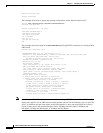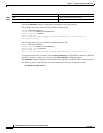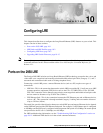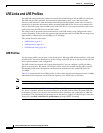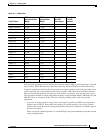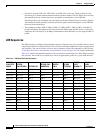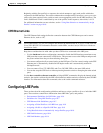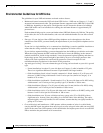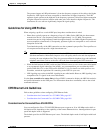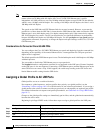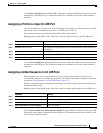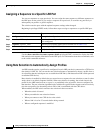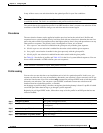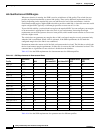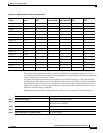
10-6
Catalyst 2950 Desktop Switch Software Configuration Guide
78-14982-01
Chapter10 Configuring LRE
Configuring LRE Ports
Environmental Guidelines for LRE Links
The guidelines for your LRE environment are based on these factors:
• Maximum distance between the LRE switch and CPE devices—LRE runs on Category 1, 2, and 3
structured and unstructured cable. The maximum distance supported on the LRE link is from 3500
to 5000 feet, depending on the profile. The higher the rate, the shorter the distance. In buildings
where LRE traffic runs over bundled telco cabling, the maximum distance is approximately 30
percent lower.
Each terminated bridge tap in a room can further reduce LRE link distances by 300 feet. The quality
of the cable, the size of the cable bundles, and cross talk within the bundle also can affect overall
reach.
• Site type—If your site has either a PBX providing telephone service throughout or has direct
connections to the PSTN, you must identify the requirements of your local public telephone service
provider.
If your site is a single building (or is a connected set of buildings), consult a qualified electrician to
ensure that the wiring conforms to the appropriate regulations for indoor circuits.
If your site has separate buildings, you must determine how the buildings are cabled to each other.
Where the wiring between the LRE switch and CPE device leaves the building (or the armored
conduits certified for inside wiring standards), it must be protected against lightning and shorts to
high-voltage power. This protection might be provided by fuses or overvoltage protectors that
comply with local regulations for outside wiring protection. Consult an expert in local
telecommunications regulations for the details of this protection.
• Age and type of wiring—You can estimate the type of wiring you have based on your site’s age and
type.
–
Newer installations less than 15 years old often use Category 3 cable in bundles of 25 pairs.
There is no significant difference between 25-pair bundles and larger bundles.
–
Older installations (hotel, school, hospital, commercial—North America) 15 to 30 years old
often use 24 AWG wiring with between 1 and 12 twists per foot (similar to Category 1) in
bundles of 25 or more.
–
Older installations (residential—North America) 15 to 30 years old often use 26 AWG wiring
with between 1 and 12 twists per foot (possibly type-2) in bundles of 100 or more.
–
Older installations (Europe) 15 to 30 years old often use 0.4 mm (similar to 26 AWG) wiring
with between 1 and 12 twists per foot in bundles of 100 or more.
–
Older installations (Asia) 15 to 30 years old often use 0.4 mm (similar to 26 AWG) wiring with
between 1 and 12 twists per foot in bundles of 100 or more.
–
Older installations over 30 years old often use heavy gauge wire (22 or 20 AWG) with no
significant twist. In many cases, the cabling is set into the fabric of the building. The cables
might be tightly or loosely bundled. For this estimate, assume that they are tightly bundled in
groups of 25 or more.
• Cross talk (noise) and interference—LRE operates with any number of wires in a cable binder
carrying the LRE signal. Anywhere from one wire pair to every wire pair in the cable can carry LRE
signals at the same time. LRE operates in full cable binders and adjusts power levels on each LRE
link to maximize the performance of all connections.



